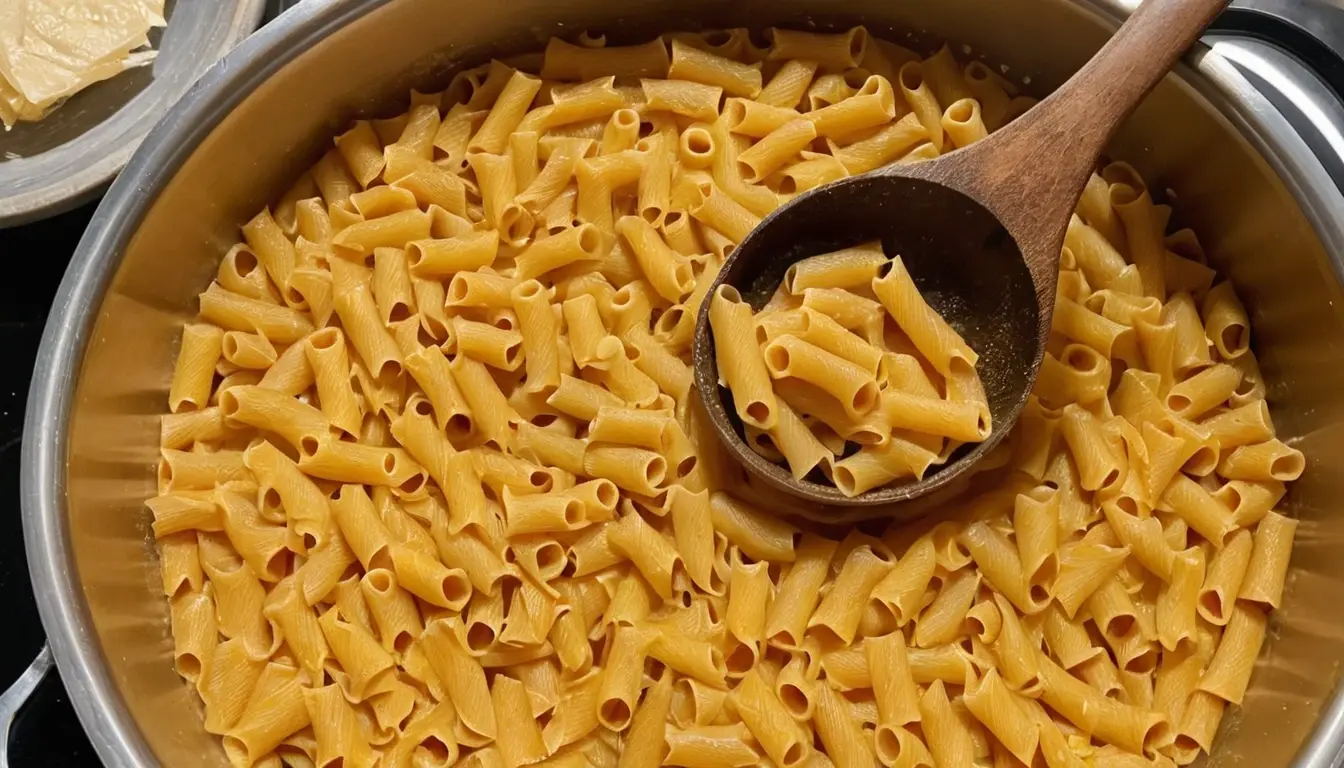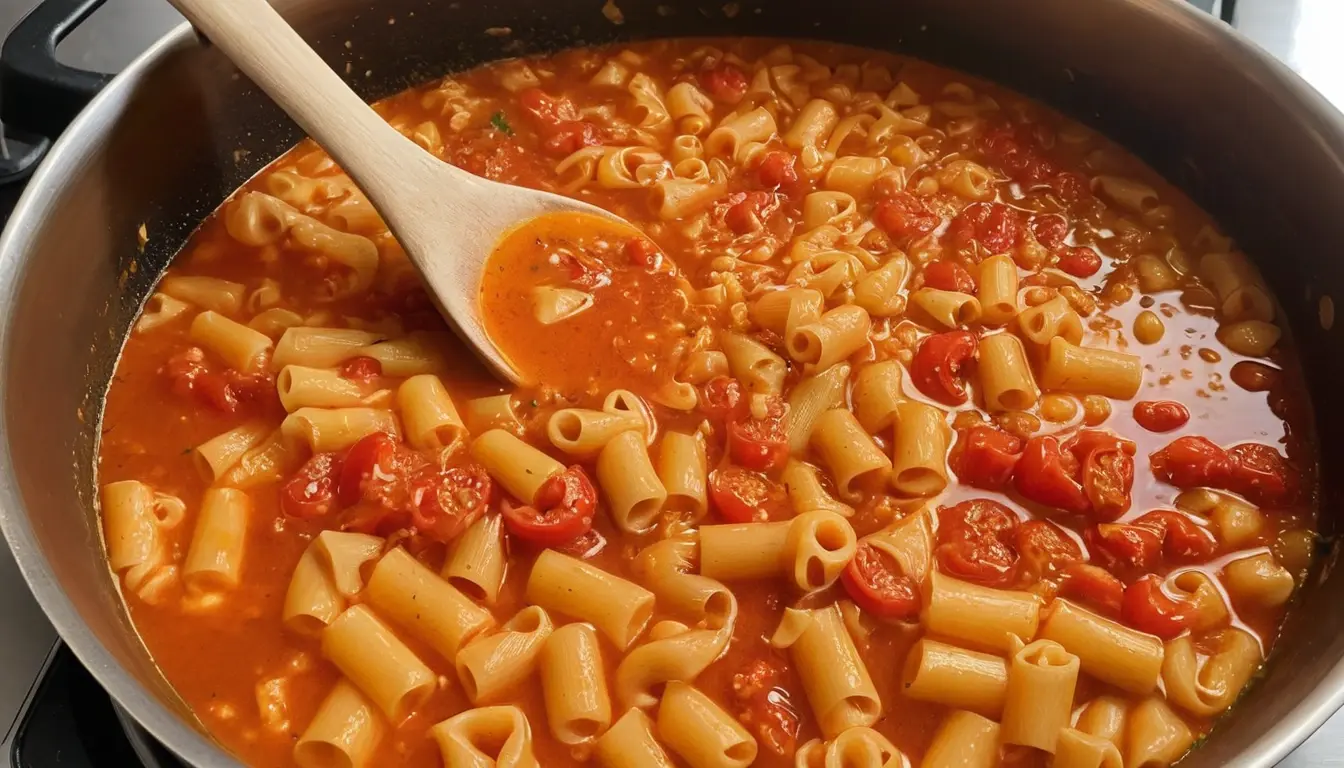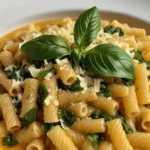If you’re looking for a simple yet satisfying dish, this Ditalini pasta recipe is the perfect choice! Ditalini, meaning “little thimbles” in Italian, is a small, tube-shaped pasta commonly used in soups, pasta salads, and creamy dishes. Its tiny size allows it to absorb flavors beautifully, making every bite rich and delicious. Whether you’re preparing a cozy homemade soup, a refreshing summer pasta salad, or a hearty baked dish, ditalini pasta delivers the perfect texture. This Ditalini pasta recipe is easy to make, incredibly versatile, and perfect for any occasion—so let’s dive in and bring this classic Italian favorite to your kitchen!
Why You Will Love This Recipe
For Miranda, this Ditalini pasta recipe is more than just a meal—it’s a cherished memory. As a child, she would watch her grandmother stir a simmering pot of ditalini soup, the warm aroma filling the kitchen. She loved the way the tiny pasta soaked up the broth, making every spoonful rich and comforting. The first time Miranda helped cook it, she felt an instant connection to her family’s tradition. Now, every bite of this Ditalini pasta recipe brings back those warm, nostalgic moments. Whether for comfort or convenience, this dish is sure to become a household favorite!
Ingredients for the Recipe
Creating the perfect Ditalini pasta recipe requires simple, fresh ingredients that come together for a comforting and flavorful dish. Below is everything you need to make this delicious pasta meal.
Base Ingredients:
- 2 cups ditalini pasta – The star of the dish, this small tube-shaped pasta absorbs flavors beautifully.
- 6 cups chicken or vegetable broth – A rich broth enhances the taste and gives the pasta a comforting, savory depth.
- 1 tablespoon olive oil – Adds richness and helps sauté the ingredients.
- 1 small onion, finely chopped – Brings a subtle sweetness and aromatic base.
- 2 cloves garlic, minced – Enhances the overall flavor with a mild kick.
- 1 cup diced tomatoes (canned or fresh) – Adds a slight tangy sweetness to balance the richness.
- ½ teaspoon salt – Essential for seasoning the broth and pasta.
- ¼ teaspoon black pepper – A touch of spice to enhance the flavors.
Flavor Enhancers:
- ½ teaspoon dried oregano – Adds an earthy, slightly peppery taste.
- ½ teaspoon dried basil – Complements the tomatoes and broth with a hint of sweetness.
- ½ cup grated Parmesan cheese – A creamy, nutty topping that ties everything together.
- ½ cup chopped fresh parsley – Brings freshness and color to the dish.
This Ditalini pasta recipe is all about simplicity and flavor. By using these fresh ingredients, you’ll achieve a dish that’s both comforting and satisfying. Now that you have everything ready, let’s move on to the tools you’ll need to bring this dish to life!

Equipment Needed
To prepare the perfect Ditalini pasta recipe, having the right kitchen tools will make the process smoother and more efficient. Here’s a list of essential equipment you’ll need.
1. Large Pot
A large pot is necessary for boiling the ditalini pasta and preparing the broth. Choose a heavy-bottomed pot to ensure even heat distribution, preventing any ingredients from sticking or burning.
2. Colander
A colander is essential for draining the pasta if you’re not cooking it directly in the broth. It helps remove excess water while keeping the pasta firm and intact.
3. Cutting Board & Sharp Knife
For chopping onions, garlic, and fresh herbs, a cutting board and a sharp knife are must-haves. A well-sharpened knife ensures precise and quick ingredient preparation.
4. Wooden Spoon or Silicone Spatula
A wooden spoon or silicone spatula is great for stirring the ingredients, ensuring they don’t stick to the bottom of the pot while cooking.
5. Measuring Cups & Spoons
To maintain the perfect balance of flavors in this Ditalini pasta recipe, accurate measurements are key. Use measuring cups and spoons for broth, pasta, spices, and seasonings.
6. Ladle
If serving the Ditalini pasta recipe as a soup, a ladle makes it easy to portion out the perfect serving.
With these simple kitchen tools, making this Ditalini pasta recipe becomes an effortless and enjoyable experience. Now, let’s dive into the best tips to ensure your dish turns out perfect every time!
Tips for the Best Results
Making the perfect Ditalini pasta recipe is all about the right techniques and little details that elevate the dish. Follow these expert tips to ensure your pasta turns out flavorful, well-textured, and absolutely delicious.
1. Cook the Pasta to Al Dente
Ditalini pasta absorbs a lot of liquid, so cooking it al dente (firm to the bite) is key. If adding it directly to a soup or sauce, undercook it slightly so it doesn’t become mushy as it continues to absorb liquid.
2. Salt the Water Generously
If boiling the pasta separately, always salt the water before cooking. This enhances the pasta’s flavor and ensures the entire dish is well-seasoned from the start.
3. Use Homemade Broth for More Flavor
A high-quality broth makes all the difference in a Ditalini pasta recipe. Homemade chicken or vegetable broth adds depth and richness compared to store-bought versions. If using store-bought, opt for low-sodium to control the salt level.
4. Stir Frequently to Prevent Sticking
Ditalini is a small pasta that can clump together. Stirring regularly while cooking prevents it from sticking and ensures even cooking.
5. Let the Flavors Marry
For the best taste, let the finished dish sit for a few minutes before serving. This allows the flavors of the broth, seasonings, and pasta to meld beautifully.
By following these tips, your Ditalini pasta recipe will turn out perfectly cooked, well-balanced, and packed with flavor every single time! Now, let’s explore the best ways to serve this delicious dish.
Serving Suggestions
The beauty of this Ditalini pasta recipe lies in its versatility. Whether you’re enjoying it as a comforting soup, a creamy pasta dish, or a light salad, there are endless ways to serve and elevate this classic recipe. Here are some of the best serving ideas!
1. Classic Ditalini Soup
Ditalini pasta is most commonly used in soups like Pasta e Fagioli or classic vegetable soup. Serve it with a sprinkle of Parmesan cheese, a drizzle of olive oil, and a slice of warm crusty bread for the ultimate cozy meal.
2. Creamy Ditalini Pasta
For a richer dish, mix the cooked pasta with a light cream sauce, fresh basil, and sun-dried tomatoes. Top it with grated Parmesan and black pepper for an indulgent twist on the traditional Ditalini pasta recipe.
3. Cold Ditalini Pasta Salad
This pasta is perfect for salads! Toss cooked and cooled ditalini with cherry tomatoes, cucumbers, olives, feta cheese, and a zesty vinaigrette. This refreshing dish is perfect for summer picnics or meal prep.
4. As a Side Dish
Ditalini pasta pairs wonderfully with grilled meats, roasted vegetables, or seafood. Serve it with a lemon-garlic butter sauce alongside grilled shrimp or roasted chicken for a simple yet delicious meal.
No matter how you serve it, this Ditalini pasta recipe is guaranteed to be a hit. Now, let’s explore more delicious recipes you might love!

Recommended Recipes
If you love this Ditalini pasta recipe, you’ll definitely want to try these other delicious pasta dishes from Milestone Recipes. These recipes highlight the versatility of ditalini pasta and other comforting Italian-inspired flavors.
1. Ditalini Pasta Guide: Uses & Recipes
This guide explores different ways to use ditalini pasta in soups, salads, and baked dishes. Whether you want a creamy pasta bake or a simple broth-based meal, this resource is packed with inspiration.
2. Garlic Parmesan Chicken Pasta
A rich and creamy pasta dish featuring a garlicky Parmesan sauce, tender chicken, and perfectly cooked pasta. While it traditionally uses larger pasta, ditalini would be a great substitute for a heartier bite.
3. Marry Me Chicken Pasta
A decadent dish that combines creamy tomato-based sauce, Parmesan cheese, and seasoned chicken with pasta. This indulgent meal pairs beautifully with ditalini for a unique twist.
These recipes offer great alternatives and variations for your Ditalini pasta recipe. Whether you want to explore different sauces, protein additions, or cooking methods, these dishes will expand your pasta repertoire!
Notes
Before making this Ditalini pasta recipe, here are some important notes and variations to help customize the dish to your preference. These tips ensure the best texture, flavor, and presentation every time.
1. Substitutions and Variations
- Broth Options: While chicken broth is traditional, vegetable broth makes a great vegetarian alternative. For a richer flavor, try using bone broth.
- Gluten-Free Alternative: Swap regular ditalini pasta with a gluten-free variety made from chickpeas, rice, or lentils.
- Protein Additions: To make this Ditalini pasta recipe heartier, add cooked Italian sausage, shredded chicken, or cannellini beans.
- Dairy-Free Version: Omit Parmesan cheese and use nutritional yeast for a cheesy flavor without dairy.
- Extra Veggies: Add diced carrots, celery, spinach, or zucchini to increase the nutritional value of your dish.
2. Storage Tips
- Refrigeration: Store leftovers in an airtight container for up to 4 days. Reheat with a splash of broth to maintain the pasta’s texture.
- Freezing: If making a soup version, freeze it without the pasta to prevent it from becoming mushy. Cook fresh ditalini when ready to serve.
3. Preventing Overcooked Pasta
- If cooking ditalini in broth, add it towards the end of cooking to keep it from getting too soft.
- For pasta salads, rinse cooked pasta under cold water to stop the cooking process and prevent sticking.
By keeping these notes in mind, your Ditalini pasta recipe will always turn out flavorful, fresh, and perfectly textured!
FAQ
Here are some common questions and answers to help you make the perfect Ditalini pasta recipe every time.
1. What is the best sauce for ditalini pasta?
Ditalini pasta pairs well with both light and rich sauces. Classic tomato sauce, creamy Alfredo, garlic butter, and pesto all work beautifully. It also absorbs flavors well in soups and brothy dishes.
2. Can I make ditalini pasta from scratch?
Yes! If you have a pasta maker, you can create homemade ditalini using semolina flour and eggs. Cut small tubes and dry them before cooking for the best texture.
3. How do I store leftover ditalini pasta?
Store cooked pasta in an airtight container in the refrigerator for up to four days. If it’s part of a soup, the pasta may continue absorbing liquid, so add extra broth when reheating.
4. Can I use ditalini in cold pasta salads?
Absolutely! Ditalini’s small size makes it perfect for pasta salads. Rinse it under cold water after cooking, then toss with olive oil, vegetables, cheese, and dressing for a refreshing dish.
5. What’s the best way to reheat ditalini pasta?
Reheat it on the stovetop with a splash of broth or sauce to restore moisture. Avoid microwaving without liquid, as it can dry out the pasta.
6. Is ditalini pasta gluten-free?
Traditional ditalini pasta contains wheat, but there are gluten-free options available made from rice, quinoa, or lentils. Choose a high-quality brand for the best taste and texture.
With these tips, your Ditalini pasta recipe will always turn out perfect, whether you’re making a warm, comforting dish or a refreshing pasta salad!
Conclusion
The Ditalini pasta recipe is more than just a dish—it’s a warm and comforting experience that brings people together. Its versatility makes it perfect for soups, creamy pastas, or refreshing salads, and with the right ingredients and techniques, it’s always a delicious success.
For Miranda, this recipe holds a special place in her heart. She still remembers the first time she made it with her grandmother in their cozy kitchen, the rich aroma of simmering broth filling the air. As a child, she loved watching the tiny pasta pieces swirl in the pot, eagerly waiting for the moment when she could take her first bite. The warmth, the taste, and the love that went into making it became a cherished memory. Now, every time she prepares this Ditalini pasta recipe, she’s reminded of those moments of joy and connection.
Whether you’re cooking for family, hosting a dinner party, or simply looking for a quick and satisfying meal, this Ditalini pasta recipe is the perfect choice. It’s easy to make, endlessly adaptable, and guaranteed to bring comfort in every bite.
So why not try it today? Cook up a pot of ditalini, savor its flavors, and create your own special memories. One bite, and you’ll see why Miranda—and so many others—love this timeless recipe. Enjoy!
Print
Irresistible Ditalini Pasta Recipe
- Total Time: 30 minutes
Description
A classic Ditalini pasta recipe that’s perfect for soups, creamy dishes, or pasta salads. Simple ingredients come together to create a comforting and flavorful meal for any occasion.
Ingredients
- 2 cups ditalini pasta
- 6 cups chicken or vegetable broth
- 1 tablespoon olive oil
- 1 small onion, finely chopped
- 2 cloves garlic, minced
- 1 cup diced tomatoes (canned or fresh)
- ½ teaspoon salt
- ¼ teaspoon black peppe
- ½ teaspoon dried oregano
- ½ teaspoon dried basil
- ½ cup grated Parmesan cheese
- ½ cup chopped fresh parsley
Instructions
- Cook the ditalini: Boil pasta in salted water until al dente, then drain. If making soup, cook it directly in the broth.
- Sauté the aromatics: In a large pot, heat olive oil and sauté onions and garlic until fragrant.
- Add the broth and tomatoes: Pour in broth and diced tomatoes, then bring to a simmer.
- Season and combine: Stir in salt, pepper, oregano, and basil for extra flavor.
- Add pasta and cheese: Mix in cooked ditalini and let it absorb the flavors. Stir in Parmesan cheese.
- Garnish and serve: Sprinkle with fresh parsley before serving.
Notes
- For a richer flavor, use homemade broth instead of store-bought.
- To make a creamy version, stir in a splash of heavy cream before serving.
- If using ditalini in pasta salad, rinse with cold water to prevent sticking.
- Prep Time: 10 minutes
- Cook Time: 20 minutes
Keywords: Ditalini Pasta Recipe

